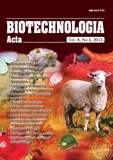ISSN 2410-776X (Online),
ISSN 2410-7751 (Print)

Biotechnologia Acta V. 8, No 3, 2015
https://doi.org/10.15407/biotech8.03.104
Р. 104-109, Bibliography 18, English
Universal Decimal Classification: 577.15 (088.8)
MUCOADHESIVE GEL WITH IMMOBILIZED LYSOZYME: PREPARATION AND PROPERTIES
Dekina S. S., Romanovska I. I., Leonenko І. І., Yegorova A. V.
Bogatsky Physico-Chemical Institute of the National Academy of Sciences of Ukraine, Odesa
The study of non-covalent immobilized lysozyme, as well as physico-chemical and biochemical properties of obtained mucoadhesive gel was the aim of the research. Lysozyme activity was determined by bacteriolytic method (Micrococcus lysodeikticus cells acetone powder was a substrate). Lysozyme immobilization was conducted by the method of entrapment in gel. Enzyme carrier interaction was studied by viscometric, spectrophotometric and spectrofluorimetric methods. Mucoadhesive gel with immobilized lysozyme, possessing antiinflammatory and antimicrobial activities, was prepared. Due to immobilization, protein-polymer complex with the original enzymatic activity was formed. The product is characterized by high mucoadhesive properties, quantitative retaining of protein and bacteriolytic activity, prolonged release of the enzyme, improved biochemical characteristics (extended pH-activity profile, stability in acidic medium and during storage for 2 years), and it is perspective for further studies. The proposed method for lysozyme immobilization in the carboxymethyl cellulose sodium salt gel allows to obtain a stable, highly efficient product, with high adhesive properties for attachment to the mucous membranes, that is promising for use in biomedicine.
Key words: lysozyme, immobilization, mucoadhesive gel.
© Palladin Institute of Biochemistry of the National Academy of Sciences of Ukraine, 2015
References
1. State Pharmacopoeia of Ukraine. Supplement 2. DP «Nauk.-exp. farm. center». 1st ed. Kharkiv: RІREG. 2007, 617 p. (In Ukrainian).
2. Pirasa A. M., Maisettab G., Sandreschi S. Preparation, physical-chemical and biological haracterization of chitosan nanoparticles loaded with lysozyme. Int. J. Biol. Macromol. 2014, V. 67, P. 124–131. doi:10.1016/j.ijbiomac.2014.03.016.
3. Takahashi D., Hamada T., Izumi T. Immobilization of lysozyme on poly(N-isopropyl acrylamide)/2-hydroxyethyl methacrylate copolymer core–shell gel beads. Polym. Bull. 2012, 68 (6), 1777–1788. doi:10.1007/s00289-012-0715-0.
4. Anirudhan T. S., Rauf T. A. Lysozyme immobilization via adsorption process using sulphonic acid functionalized silane grafted copolymer. Colloids Surf. B Biointerfaces. 2013, V. 107, P. 1–10. doi:10.1016/j.colsurfb.2013.01.063.
5. Xiao Q., Tao X., Zou H. Comparative study of solid silica nanoparticles and hollow silica nanoparticles for the immobilization of lysozyme. Chem. Eng. J. 2008, 137 (1), 38–44. doi:10.1016/j.cej.2007.09.012.
6. Lu Z., Zhang J., Ma Y. Biomimetic mineralization of calcium carbonate/carboxymethylcellulose microspheres for lysozyme immobilization. Mater. Sci. Eng. C. 2012, 32 (7), 1982–1987. doi:10.1016/j.msec.2012.05.027.
7. Hanu?ov? K., V?penka L., Dobi?? J. Development of antimicrobial packaging materials with immobilized glucose oxidase and lysozyme. Cent. Eur. J. Chem. 2013, 11 (7), 1066–1078. doi:10.2478/s11532-013-0241-4.
8. Kuijpersa A. J., Wachemb P. B., Luyn M. J. In vivo and in vitro release of lysozyme from cross-linked gelatin hydrogels: a model system for the delivery of antibacterial proteins from prosthetic heart valves. J. Contr. Release. 2000, 67 (1–2), 323–336.
doi:10.1016/S0168-3659(00)00221-2.
9. Weia L., Caia C., Lin J. Degradation controllable biomaterials constructed from lysozymeloaded Ca-alginate microparticle/chitosan composites. Polymer. 2011, 52 (22), 5139–5148. doi:10.1016/j.polymer.2011.09.006.
10. Dekina S. S. Romanovskaya I. I., Ovsepyan A. M., Molodaya A. L., Pashkin I. I. Immobilization of lysozyme in polyvinyl alcohol cryogel. Biotechnol. acta. 2014, 7 (3), 69–73.
doi: 10.15407/biotech7.03.069. (In Russian).
11. Levitskiy A. P. Lysozyme instead of antibiotics. Odesa: KP OGT. 2005, 74 p. (In Russian).
12. Hartree E. F. Determination of protein: a modification of the Lowry method, that gives a linear photometric response. Anal. Biochem. 1972, 48 (2), 422–427.
13. Bartenev G. M., Frankel S. J. Polymer physics. Leningrad: Khimiya. 1990, 332 p. (In Russian).
14. Levitsky A. P., Selivanska I. A., Furdychko A. I. Phytogel for dentistry. and others. Patent 78112 Ukraine, MPK (2013.01) А61К 8/30 (2006.01), А61К 8/97 (2006.01), А61Q 11/00. March 11, 2013.
15. Demina N. B., Larionova N. I., Kharenko E. A. Mucoadhesive drug delivery systems: quantitative assessment of interaction between synthetic and natural polymer films and mucosa. Pharmaceut. Chem. J. 2008, 42 (7), 392–399.
doi:10.1007/s11094-008-0132-8.
16. Lapach S. N., Tschubenko A. V., Babich P. N. Statistical methods in biomedical research using Excel. Кyiv: Morion. 2000, 320 p. (In Russian).
17. Rogovin Z. A. Chemistry of cellulose. Moskva: Khimiya. 1972, P. 402–404. (In Russian).
18. Kuzin M. I. Wounds and wound infection. Moskva: Medicina. 1990, 484 p. (In Russian).

